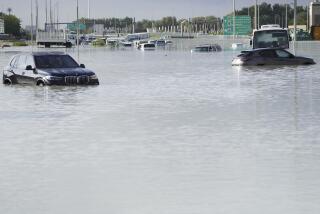Planes may increase snowfall at times
Next time you get snowed in at the airport, you might want to blame the planes.
A new report has found that planes flying through certain kinds of clouds can seed ice crystals and create additional snowfall. Conditions that allow this seeding effect occur up to 6% of the time at six airports assessed in the study, which was published in the journal Science.
The extra snowfall is associated with odd-looking gashes and gaping holes seen in certain clouds — called “hole-punch” and “canal” clouds — that are formed by airplanes flying through them.
Scientists had known for years that passing aircraft can generate ice crystals in clouds, but until recently they hadn’t associated that process with the mysterious holes, said Andrew Heymsfield, a senior scientist at the National Center for Atmospheric Research in Boulder, Colo., and lead author of the study. His team decided to explore a possible connection.
They studied satellite images taken over a four-hour period on Jan. 29, 2007, that showed a series of holes and canals in a cloud layer over Texas. Analysis of the layer showed that it was made up primarily of liquid water droplets.
The scientists measured the holes and canals they saw, and then looked at Federal Aviation Administration records to determine what aircraft produced them. They found that “a full spectrum of aircraft types” had been involved, including passenger and military jets of varying sizes, as well as planes with propellers.
They then used computer models to simulate the process that had taken place.
According to Heymsfield, the very mechanisms that help keep airplanes aloft — air expanding around propeller tips to generate thrust, or expanding over a jet’s wing to provide lift — also cool the air by as much as 86 degrees Fahrenheit.
When that cooling occurs as an aircraft flies through a special kind of cloud — one made up of supercooled water that remains liquid even below the freezing point — it can create ice crystals. These ice crystals attract the supercooled water droplets around them, much as a cool mirror in your bathroom condenses steam from your shower.
When the ice crystals grow large enough, they fall as precipitation.
Because the process generates heat, it also creates circulation within the cloud that drives the hole to grow larger. “The thing spreads with time,” Heymsfield said.
The process also creates snow — an amount that might make a difference near airports where the right conditions exist, he added.
At the Denver airport, he said, planes typically take off into the wind. If they’re generating ice in the lower-level clouds, that snow-spawning region could drift over the airport and produce conditions that require de-icing.
“In the wintertime, when storm tracks are frequent, this could be 10-15% of the time,” Heymsfield said. “This doesn’t have any implications in terms of Earth’s climate, that’s for sure. But regionally there might be more precipitation.”
Other scientists said they doubted that the airplane-induced snow would amount to much.
Art Rangno, a retired flight scientist at the University of Washington in Seattle who was not involved in this study, said the work reminded him of a colleague’s remark during a cloud-seeding experiment: that any additional rainfall created would be “enough to fill a ladybug’s teacup.”
“I think that could be the case here,” Rangno said.
Graeme Stephens, director of the Center for Climate Sciences at the Jet Propulsion Laboratory in La Cañada-Flintridge, agreed.
“These clouds are very specialized,” he said. “They don’t occur very often.”
Still, Stephens, who also was not involved in the research, thought the discovery was interesting from a scientific point of view, because researchers have had a tough time modeling and quantifying how ice in clouds creates precipitation.
“This lets us see the mechanism in a unique way,” he said. “They’ve demonstrated the process in a way we wouldn’t have anticipated.”







